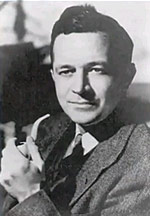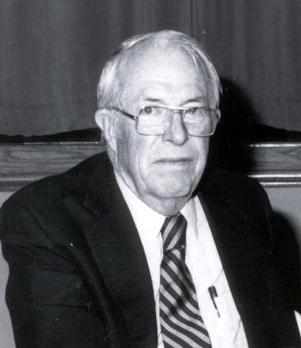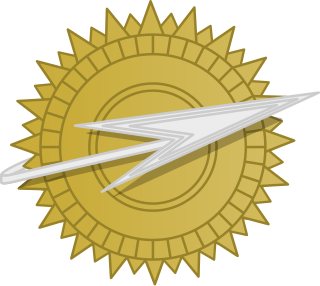
Murray Leinster was a pen name of William Fitzgerald Jenkins, an American writer of genre fiction, particularly of science fiction. He wrote and published more than 1,500 short stories and articles, 14 movie scripts, and hundreds of radio scripts and television plays.
A future history is a postulated history of the future and is used by authors of science fiction and other speculative fiction to construct a common background for fiction. Sometimes the author publishes a timeline of events in the history, while other times the reader can reconstruct the order of the stories from information provided therein.

Alien invasion or space invasion is a common feature in science fiction stories and film, in which extraterrestrial lifeforms invade the Earth to exterminate and supplant human life, enslave it, harvest people for food, steal the planet's resources, or destroy the planet altogether. It can be considered as a science-fiction subgenre of the invasion literature, expanded by H. G. Wells's seminal alien invasion novel The War of the Worlds.
Galactic empires are a common trope used in science fantasy and science fiction, particularly in works known as 'space operas'. Many authors have either used a galaxy-spanning empire as background or written about the growth and/or decline of such an empire. The capital of a galactic empire is frequently a core world, such as a planet relatively close to a galaxy's supermassive black hole, which has advanced considerably in science and technology compared to current human civilization. Characterizations can vary wildly from malevolent forces attacking sympathetic victims to apathetic bureaucracies to more reasonable entities focused on social progress and anywhere in between.

The Lensman series is a series of science fiction novels by American author E. E. "Doc" Smith. It was a runner-up for the 1966 Hugo award for Best All-Time Series, losing to the Foundation series by Isaac Asimov.

An overwhelming majority of fiction is set on or features the Earth, as the only planet home to humans. This also holds true of science fiction, despite perceptions to the contrary. Works that focus specifically on Earth may do so holistically, treating the planet as one semi-biological entity. Counterfactual depictions of the shape of the Earth, be it flat or hollow, are occasionally featured. A personified, living Earth appears in a handful of works. In works set in the far future, Earth can be a center of space-faring human civilization, or just one of many inhabited planets of a galactic empire, and sometimes destroyed by ecological disaster or nuclear war or otherwise forgotten or lost.

John Stewart Williamson, who wrote as Jack Williamson, was an American science fiction writer, one of several called the "Dean of Science Fiction". He is also credited with one of the first uses of the term genetic engineering. Early in his career he sometimes used the pseudonyms Will Stewart and Nils O. Sonderlund.
The concept of self-replicating spacecraft, as envisioned by mathematician John von Neumann, has been described by futurists including physicist Michio Kaku and discussed across a wide breadth of hard science fiction novels and stories. Self-replicating probes are sometimes referred to as von Neumann probes. Self-replicating spacecraft would in some ways either mimic or echo the features of living organisms or viruses.

The Galactic Empire is an interstellar empire featured in Isaac Asimov's Robot, Galactic Empire, and Foundation series. The Empire is spread across the Milky Way galaxy and consists of almost 25 million planets settled exclusively by humans. For over 12 millennia the seat of imperial authority was located on the ecumenopolis of Trantor, whose population exceeded 40 billion, until it was sacked in the year 12,328. The official symbol of the empire is the Spaceship-and-Sun. Cleon II was the last Emperor to hold significant authority. The fall of the empire, modelled on the fall of the Roman Empire, is the subject of many of Asimov's novels.
Christopher Anvil is a pseudonym used by American author Harry Christopher Crosby.

First contact is a common science fiction theme about the first meeting between humans and extraterrestrial life, or of any sentient species' first encounter with another one, given they are from different planets or natural satellites. The theme allows writers to explore such topics such as xenophobia, transcendentalism, and basic linguistics by adapting the anthropological topic of first contact to extraterrestrial cultures.

Jupiter, the largest planet in the Solar System, has appeared in works of fiction across several centuries. The way the planet has been depicted has evolved as more has become known about its composition; it was initially portrayed as being entirely solid, later as having a high-pressure atmosphere with a solid surface underneath, and finally as being entirely gaseous. It was a popular setting during the pulp era of science fiction. Life on the planet has variously been depicted as identical to humans, larger versions of humans, and non-human. Non-human life on Jupiter has been portrayed as primitive in some works and more advanced than humans in others.

Cities in Flight is a four-volume series of science fiction novels and short stories by American writer James Blish, originally published between 1950 and 1962, which were first known collectively as the "Okie" novels. The series features entire cities that are able to fly through space using an anti-gravity device, the spindizzy. The stories cover roughly two thousand years, from the very near future to the end of the universe. One story, "Earthman, Come Home", won a Retro Hugo Award in 2004 for Best Novelette. Since 1970, the primary edition has been the omnibus volume first published in paperback by Avon Books. Over the years James Blish made many changes to these stories in response to points raised in letters from readers.

Sucker Bait is a science fiction novella by American writer Isaac Asimov. It was first serialized in the February and March 1954 issues of Astounding Science Fiction, and reprinted in the 1955 collection The Martian Way and Other Stories. It has also been adapted as an episode of the BBC anthology television series Out of the Unknown.
"Homo Sol" is a science fiction short story by American writer Isaac Asimov. It was first published in the September 1940 issue of Astounding Science Fiction and reprinted in the 1972 collection The Early Asimov. It deals with the proposed acceptance into a galactic federation of hominid civilizations of the hominids of newly discovered Earth.
The planetary systems of stars other than the Sun and the Solar System are a staple element in many works of the science fiction genre.

The Psychotechnic League is a future history created by American science fiction writer Poul Anderson. The name "Psychotechnic League" was invented by Sandra Miesel during the early 1980s, to capitalize on Anderson's better-known Polesotechnic League future history. Anderson published 21 novels, novellas and short stories set in this future between 1949 and 1957, with a 22nd published in 1968.
"Entity" is a science fiction short story by American writers Poul Anderson and John Gergen, which appeared in the June 1949 issue of Astounding Science Fiction. "Entity" was the fifth story published by Anderson, and the only story published by Gergen, a friend of him from the Minneapolis Fantasy Society.
'"Marius" is a science fiction short story by American writer Poul Anderson, first published in the March 1957 issue of Astounding Science Fiction and reprinted in the collections The Horn of Time (1968) and The Psychotechnic League (1981). As a component of the Psychotechnic League future history / alternate history, "Marius" takes place in 1964, six years after the initial nuclear exchanges of World War III. Although it is chronologically the first story in the Psychotechnic League sequence, "Marius" was one of the last to be written. It serves as a prequel to the earlier novella "Un-Man", introducing the character of Étienne Fourre.

Probability Sun is a 2001 science fiction novel by American writer Nancy Kress, a sequel to her 2000 publication Probability Moon. It was followed in 2002 by Probability Space, which won the John W. Campbell Memorial Award.












